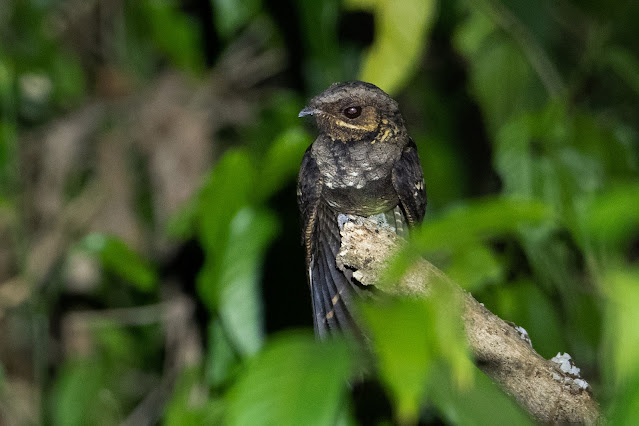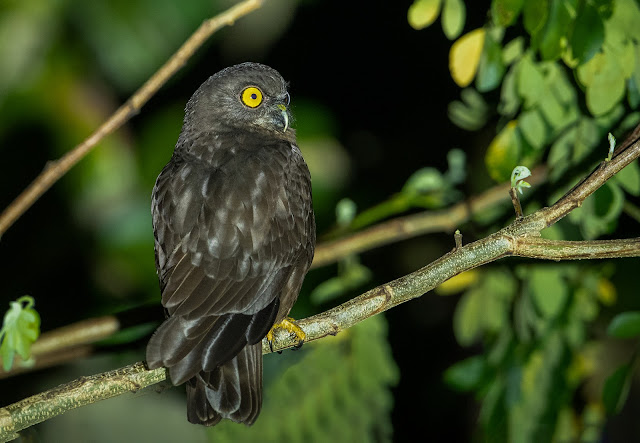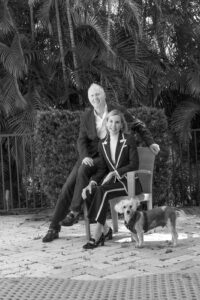Andaman and Nicobar Islands were formed due to a collision between Indian Plate and Burma Minor Plate, there are many such theories that suggest how the formation of Andaman and Nicobar Islands may have taken place, though neither of the theories have been completely...
Andaman and Nicobar Islands were formed due to a collision between Indian Plate and Burma Minor Plate, there are many such theories that suggest how the formation of Andaman and Nicobar Islands may have taken place, though neither of the theories have been completely accepted or denied.
All we are sure is that these forces of nature did give us a wonderful island, that in now in the middle of a turquoise blue sea with some endemic species of birds, which simply means these species are not found elsewhere, giving us a very good reason to be there so see them.
The Andaman islands are divided into three main islands i.e. North, Middle and South. While, among the Nicobar islands, the Great Nicobar is the largest. It is the southernmost island of India and is very close (180kms) to Sumatra island of Indonesia. We choose to spend one week in South Andaman and one week in Great Nicobar (which got extended to 10 days in each place, due to the delay of the ship sailings into Campbell bay from Port Blair)
The areas we covered and visited in South Andaman between 9th March 2021 to 15th March 2021
1. Chidya Tapu Biological Park and adjacent areas of the Reserve forest
The region is about 35-45 minutes (18kms) drive and our first destination for this trip, after landing in Port Blair in the afternoon. On the edge of the Biological park, there is a sunset point, which looked amazing. Along this small beach a food stall offered assorted fritters (banana and potato) with spiced tea. We munched on these snacks and waited patiently for the sun to set, not because we wanted to rest, but because it’s the time one can see the nocturnal species that are endemic to the region.
 |
| Sunset at Chidya tapu - Image by Aseem Kothiala |
Over the two visits to the region we saw Andaman Nightjar, Hume’s Boobook, Andaman Boobook and Oriental scops Owls (Walden’s) during the night and to our joy the endemic Andaman Crake during the day.
 |
| Oriental Scops-Owl (Walden's) - Image by Yash Kothiala |
 |
| Andaman Boobook - Image by Aseem Kothiala |
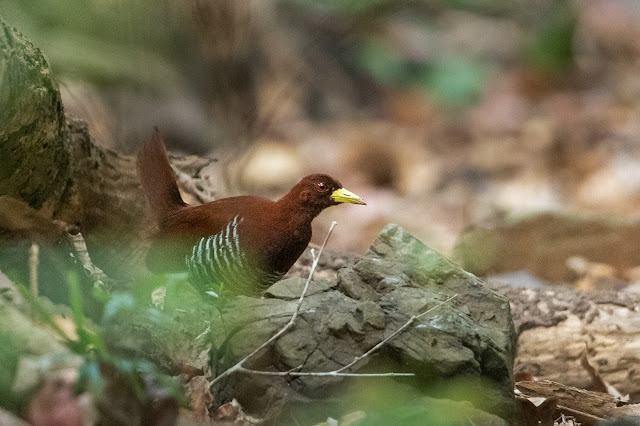 |
| Andaman Crake - Image by Yash Kothiala |
After each sighting we would hear Dhanish hum a song, for the ones who know him surely know he is a talented singer too!
One can stop en route at the beach to look for the White-bellied Sea-Eagle and Collared Kingfisher. We explored the areas of Munda beach, where we sighted the Pacific Swallow just after we visited the Biological park.
 |
| Andaman Serpent-Eagle - Image by Yash Kothiala |
As we continued walking we could see the Plume-toed Swiftlet and Brown-throated Needletails doing their acrobatic flights. On the way out at the entrance, sighted the beautiful Violet cuckoo and a pair of Vernal hanging parrot apart from a flock of White headed starlings, that were feedings on a fruiting tree near the parking area.
Adjacent to the biological park is Badabalu beach, which is pristine but it’s a good long walk from the area where one can park the vehicle. It was low tide, when we visited and sighted Collared and Stork-billed Kingfishers apart from the nesting of the Plume-toed Swifts (under a bridge) and a pair of nesting White-breasted Woodswallow.
2. Mount Harriet National Park
Mount Harriet is the highest peak in south Andaman island and the second-highest peak in the whole of the Andaman islands. To reach this place from Chatham Wharf we took the ferry that accommodates passenger and the vehicles that want to reach Bambooflat Wharf.
We heard the calls of the Andaman crake, on the trek that leads to kalaphathar, however sighting one did not seem easy. We kept birding around the stretch of main road that led to the National Park, sighting the Andaman Coucal and Andaman Bulbul to name a few.
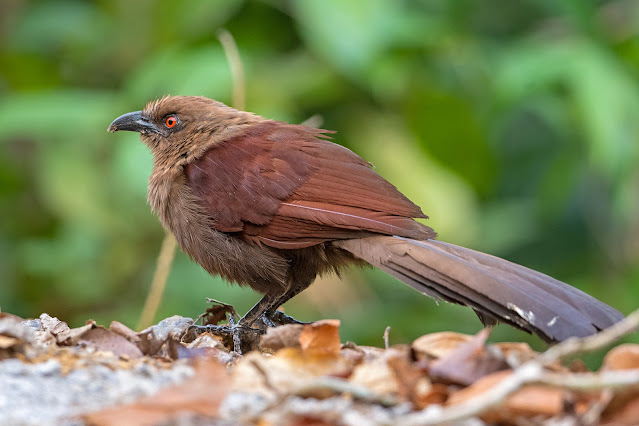 |
| Andaman Coucal - Image by Aseem Kothiala |
The view from the watchtower was amazing and birds like the Dollarbird, Vernal Hanging Parrot were seen apart from Green imperial pigeons.
3. Sippi Ghat and Jirkatang
An excellent place to see waders like the Long-toed Stint and the Red-necked Stint along with the commoners. Some water bodies that were created after the 2004 Tsunami are now being reclaimed by the land owners. Common Snipes and Oriental Pratincole’s were seen. The region was just about 6-7 kms from city of Port Blair
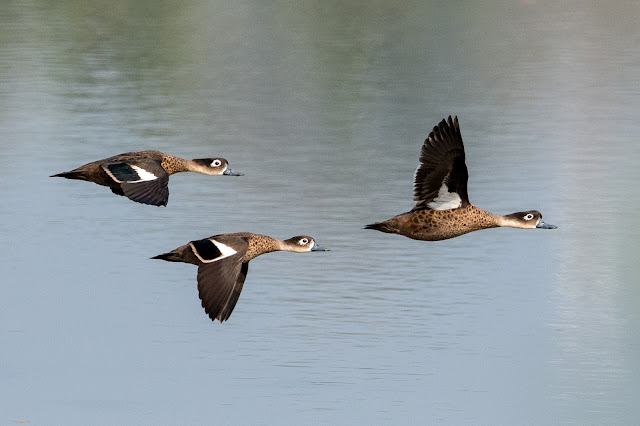 |
| Andaman Teal - Image by Aseem Kothiala |
There was a pathway that went around this large water body and we decided to walk around it, Andaman coucal kept calling but would not oblige and pose. Olive-backed Sunbirds are seen in good numbers here.
We drove further ahead towards Jirkatang on the highway that was under repair, the bird density in the forest around here was less, probably due to disturbance caused by construction. We heard and saw a flock of Andaman bulbul’s here. This region passes through the territory which was once inhabited by the Jarwa tribe, who still occupy regions that are deeper into the forest.
The weather was very humid and the morning sun was shining very bright so we decided to drive back, as usual Dhanish opted to walk for some more time, we were rewarded as we sighted the endemic Andaman wood pigeon, there was a pair who barely sat for less than minute, before disappearing into the dense forest.
 |
| Andaman Wood-Pigeon - Image by Aseem Kothiala |
4. Forests and Mangroves in Shoal Bay
Shoalbay a village in south Andaman was one of the destinations we visited twice. Each time, we would drive to Chattam wharf and take a ferry to Bambooflat wharf, the journey on this boat was around 20 minutes and then continue driving further to the forests that exists after a place called Wimberlyganj
We walked on the road that lead to Shoal bay, that was paved amongst the stretches of forest, a lot of endemic and common species were sighted here, like the Andaman treepie, Andaman bulbul, Asian fairy Bluebirds, Orange-headed Thrush , Forest Wagtail, Andaman Drongo, Andaman Cuckooshrike, Andaman green pigeon.
Trees were tall and seemed even longer here compared to Jirkatang. We gazed into them, rays of the morning sun that came through the branches was clearing the morning mist, the phenomena looked mesmerising. Long-tailed Parakeets and Asian glossy starlings were seen in good numbers. They were chasing each other away from nest holes. The forests echoed with bird calls. Listening to them with eyes closed felt blissful.
 |
| Andaman Woodpecker - Image by Aseem Kothiala |
Today the Ruddy Kingfisher was not sighted in the mangrove forest along the road and may have gone deeper inside, so we decided to travel further into Shoal bay. While we waited for the Ruddy Kingfisher to show up, sighted the Dusky warbler that was busy hunting and moving swiftly.
As sun set, Dhanish quickly spotted Andaman scops-Owl who was surely giving us some tough looks, obviously we were intruders in his territory. Must admit, Dhanish surely had a keen sense to spot these nocturnal species.
 |
| Andaman Scops-Owl - Image by Yash Kothiala |
We drove back to Chatham wharf via Bambooflat Wharf to return to this amazing Hotel Seascape in Port Blair, where we were put up. Must mention the rooms here are immaculate and meals served during our stay, was one of the finest we ever had on a birding trip. The owners (Ms. Punam Nanda and Capt Nanda) and her staff offered the hospitality that was in a class of its own.
We had not realised that the whole week had passed away and it was time to wind up and pack to head out to the next island.
Early morning of the 16th of March, we headed out to towards Haddo Wharf, to board the ship to Great Nicobar. The ship sails from Port Blair along the island of Little Andaman before taking a stop at Kamorta, (depending on the cargo that has to be offloaded) and reach its final destination Campbell Bay. Just before we reached Campbell Bay, the Andaman sea looked fabulous and to add to its beauty, saw some dolphins breaching, most likely were bottlenose dolphins.
 |
| Sunset in the ocean from the ship - Image by Yash Kothiala |
Great Nicobar
Great Nicobar is the very last island of the Andaman and Nicobar archipelago. It is the largest of the Nicobar group of islands, and is home to just about 10000 people. A large portion of the island is covered by dense forests which are home to a variety of endemic biodiversity including the Nicobar Scrubfowl (commonly called the Nicobar Megapode), the Nicobar tree shrew and the Nicobar long-tailed macaque.
Not many visit this region, except the locals inhabitants of the island (settlers), naturalists, birders, and researchers. Tribal tourism is strictly prohibited and individuals are only allowed to interact with them for research, after seeking prior permission from the tribal council.
We visited the region between 17th March 2021 and 26th March 2021
This huge island was surely slow-paced with pristine locations that is home to a close-knit community of individuals who have made their living here over several generations. Being a small place, would see familiar faces almost daily at the restaurants, on striking a conversation with a couple of them learnt that they were offered to be settlers here by then government (1969~1971) and were given 11 to 14 acers of land each with free ration for about 5 years. Today they survive on this terrain by cultivating Coconuts and Beetle nuts.
Great Nicobar is further divided into multiple smaller towns with Campbell bay being its main area of activity. There are only two main roads, one being the north south road and the other east west road, that connects the entire island.
Great Nicobar Biosphere Reserve and Galathea National Park are the two areas which we visited, they have a great significance and cover almost 85% of this island. To enter these areas, one needs to inform the forest department in Campbell bay and seek prior permission. Both these parks are separated from each other by a forest buffer zone where the “shompens”, one of the ancient tribes inhabit.
Dhanish our guide and naturalist arranged for the nature trail in the biosphere reserve by speaking to the range forest officer in the forest department. We trekked this trail thrice and got amazing sightings of the Nicobar jungle-flycatcher and Hooded Pitta
 |
| Nicobar Jungle-flycatcher - Image by Yash Kothiala |
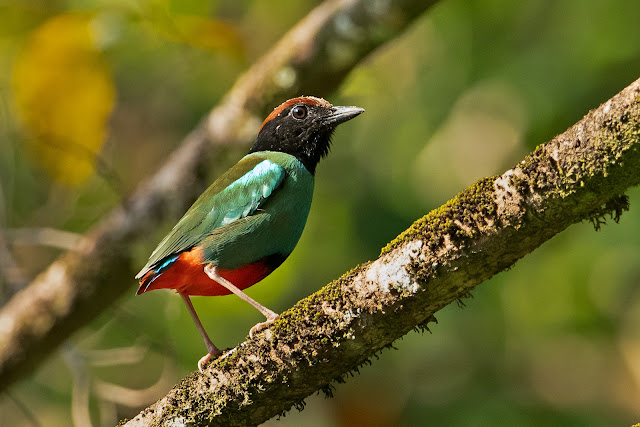 |
| Hooded Pitta - Image by Yash Kothiala |
The very shy Nicobar pigeon, only gave us glimpses as they would just disappear leaving us clueless of their existence. We saw some traps that were laid to capture them, almost 5 traps in a very small area. It seems there was a time, when sighting them wasn’t so difficult said Dhanish.
During one trek we walked up stream and sighted the Malayan night heron and heard calls of the Nicobar Scrubfowl. It had rained very heavily in the morning, the leaves and path was very moist and slippery, we thought its good, our footsteps won’t be heard and we would be able to sight the Nicobar Pigeon, instead me and Dr Ian slipped badly a couple of times, surely we escaped unhurt, with just a few bruises and scratches.
Dhanish surely loves the birds, but he surely loves the nocturnal species more, no wonder he could hear them for far and would simply follow their call and locate them. Nicobar Scops-Owl, Brown Boobook and the Grey Nightjar in a jiffy. We were happy we could see them and count our lifers
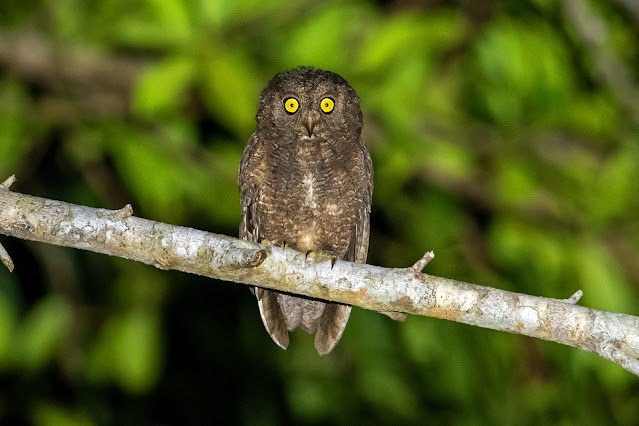 |
| Nicobar Scops-Owl - Image by Aseem Kothiala |
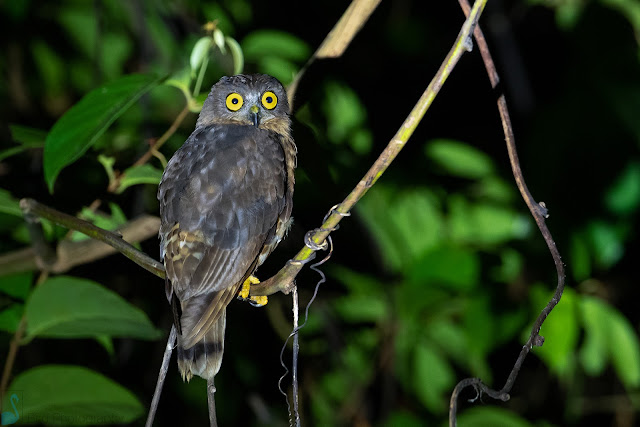 |
| Brown Boobook - Image by Yash Kothiala |
 |
| Grey Nightjar - Image by Aseem Kothiala |
Every alternate day we would drive towards Galathea National Park stopping at different locations. We felt very lucky when we sighted the Sakhalin leaf warbler, which was identified by its call and behaviour and Blyth's paradise flycatcher on one of our trips.
 |
| Blyth's Paradise-Flycatcher - Image by Aseem Kothiala |
Just along the beach within the forests, we saw a mound made of soil and vegetation, that’s when we learnt about this unique nest. The Nicobar Megapode makes them using its strong legs and lays eggs within the mound. The bird comes occasionally to inspect its nest, though the eggs hatch on their own due to the rotting vegetation. The chick can fend for themselves once they are out of the mound. We waited around for a long time, the Nicobar megapode did not show up, but a Hooded pitta was seen calling from within the foliage.
We planned to return to the site again and this time reached very early in the morning by 4.30AM after a two hour drive. Just about at sunrise is the best time to see this endemic and sensitive bird. As the day broke, noticed it was very cloudy and within moments started to pour. In about 30-40 minutes the rain subsided, but the slight drizzle was still on. This is when Dhanish came to us and said, he has seen a pair that is feeding and moving not very far from where we had taken the shelter from the downpour.
We stood still and there was an instance could see them amongst the tree barks, initially they were foraging and moving towards us and then changed course and started moving away from where we were standing and hiding. Was tempted to go out and get a better view, but knew if they heard any sound, they would be gone. So waited there hoping and praying, within a short time they changed course again and started to move just towards us. The light was low, so had to pump up the ISO and be ready.
Just after the rain the region looked even more lush and within the few falling drops of rain saw the Nicobar Megapode, walking cautiously like a model towards us. Hearing the clicks they would stop and wonder. Even we would stop clicking and wait till they get to feeding again. It was an excellent sighting.
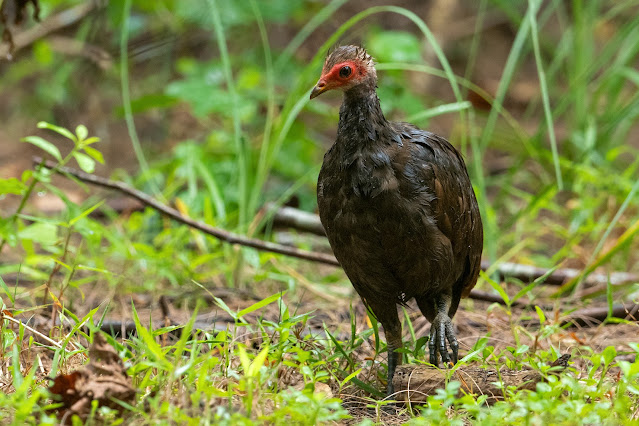 |
| Nicobar Scrubfowl - Image by Aseem Kothiala |
The region had some amazing mangrove forests, which were planted and restored after the Tsunami, water bodies and the backwaters ensured the birdlife was kept alive. Mother nature was taking good care of its creations.
The region had some amazing mangrove forests, which were planted and restored after the Tsunami, water bodies and the backwaters ensured the birdlife was kept alive. Mother nature was taking good care of its creations. |
 |
| Chinese Pond-Heron - Image by Aseem Kothiala |
We sighted the Common, Stork-billed, Black-backed Dwarf and Black-capped Kingfisher on different instances waiting along water bodies to make their catch. There was still one bird that was eluding us, the Nicobar serpent Eagle. We drove back and forth, trekked and even waited near a location where they were usually sighted. No sign, instead we saw most birds like the Common hill myna, Nicobar Parakeet, Long tailed Parakeet flying around.
It was late afternoon, sun was ready to set and we had almost retired for the session and waited near the vehicle. As always Dhanish said he will return after scanning through the region. Soon we got a call from him and he asked us to come fast, he had sighted the raptor we were looking for!
 |
| Nicobar Serpent-Eagle - Image by Aseem Kothiala |
Climate:
Most of the times, the climate was very hot and humid. Sunrises around 5am IST (Indian Standard Time) and sets by 5.30PM, surely made us feel that the first session never ends and the second session finishes very fast!
Connectivity:
BSNL offers the best connectivity in both these islands, the other networks will offer connectivity only in some parts of Port Blair (with 2G only). Internet services were available once we returned to the stay.
Permissions:
We being Indian citizens, did not require prior permission to visit the island of great Nicobar, but had to inform the forest department of our arrivals in Campbell Bay to obtain permissions to visit the Great Nicobar Biosphere Reserve and some parts of the Galathea National Park.
To visit the restricted areas, especially the one where one can watch the massive Leather backed turtles needs to approach the Office of the Principal Chief Conservator of Forest, Haddo, Port Blair.
Travel:
We had reached Port Blair by air from Mumbai. Most commonly used option to reach Campbell bay in Great Nicobar from Port Blair is by ship (a little over 500 nautical miles) and it takes about 36 hours. One can use the chopper services, which is very limited and often used by officials and islanders who have medical emergencies. Due to the recent pandemic (Covid 19) the entire process to get on to the ship seemed very challenging, sailings were restricted, seats were over booked. Thanks to efforts of Dhanish, Gokul Krishna and Peter Lobo everything went very smooth for us.
While traveling from Port Blair to Campbell Bay we were on MV Kalighat , shipmaster was Capt. Bodh Mahimairaj. He and his team were very courteous, the Chief Officer K Bala Yesu was an amazing person and ensured we had a good trip. Yash was very excited when they shared a lot of information how the vessel is kept on course by avoiding reefs and islands.
While on the way back we were on MV Coral Queen, this time the shipmaster was Capt Rohit Lal, who not only knew a lot about birds but was also interested in reptiles. This time we had Mr Sukesh Patnaik on board, who took very good care of us. To our surprise he showed us some amazing magic tricks in his free time using cards and coins, its only later we learnt he was also a professional magician. Must mention that we had a fine journey and some delicious meals. Our Sincere thanks to Satish Thayapurath who had planned this trip for us and very unfortunate that he could not join us. But he ensured we had a great trip and an amazing sailing!
The team:
We had Dhanish T leading our group, he is known as Danish Trogon in the birding circuit especially for his energetic spirt. He surely has some amazing bird spotting skills and ensured we not only saw but also got good images of the endemic species. Like a phantom (trogon) you will find him gone, we had to keep up our pace with his speed. Thanking Yash Kothiala, Marvelyn Dias and Dr Ian D’souza for being a part of this trip.
Sightings: https://ebird.org/profile/NTg5NTQ4/IN-AN
Happy Birding!
You can connect with me
ANSERIFORMES: Anatidae | |||
1 | Lesser Whistling-Duck | Dendrocygna javanica | |
2 | Cotton Pygmy-Goose | Nettapus coromandelianus | |
3 | Endemic | ||
GALLIFORMES: Megapodiidae | |||
4 | Endemic | ||
COLUMBIFORMES: Columbidae | |||
5 | Rock Pigeon | Columba livia |
|
6 | Andaman Wood-Pigeon | Columba palumboides | Endemic |
7 | Red Collared-Dove | Streptopelia tranquebarica | |
8 | Andaman Cuckoo-Dove | Macropygia rufipennis | Endemic |
9 | Asian Emerald Dove | Chalcophaps indica | |
10 | Nicobar Pigeon | Caloenas nicobarica | |
11 | Andaman Green-Pigeon | Treron chloropterus | Endemic |
12 | Green Imperial-Pigeon | Ducula aenea | |
13 | Endemic | ||
14 | Pied Imperial-Pigeon | Ducula bicolor | |
CUCULIFORMES: Cuculidae | |||
15 | Near-endemic | ||
16 | Asian Koel | Eudynamys scolopaceus | |
17 | Violet Cuckoo | Chrysococcyx xanthorhynchus | |
18 | Indian Cuckoo | Cuculus micropterus | |
CAPRIMULGIFORMES: Caprimulgidae | |||
19 | Gray Nightjar | Caprimulgus jotaka | |
20 | Andaman Nightjar | Caprimulgus andamanicus | Endemic |
CAPRIMULGIFORMES: Apodidae | |||
21 | Brown-backed Needletail | Hirundapus giganteus | |
22 | Plume-toed Swiftlet | Collocalia affinis | |
23 | White-nest Swiftlet | Aerodramus fuciphagus | |
GRUIFORMES: Rallidae | |||
24 | Eurasian Moorhen | Gallinula chloropus | |
25 | Eurasian Coot | Fulica atra | |
26 | Gray-headed Swamphen | Porphyrio poliocephalus |
|



